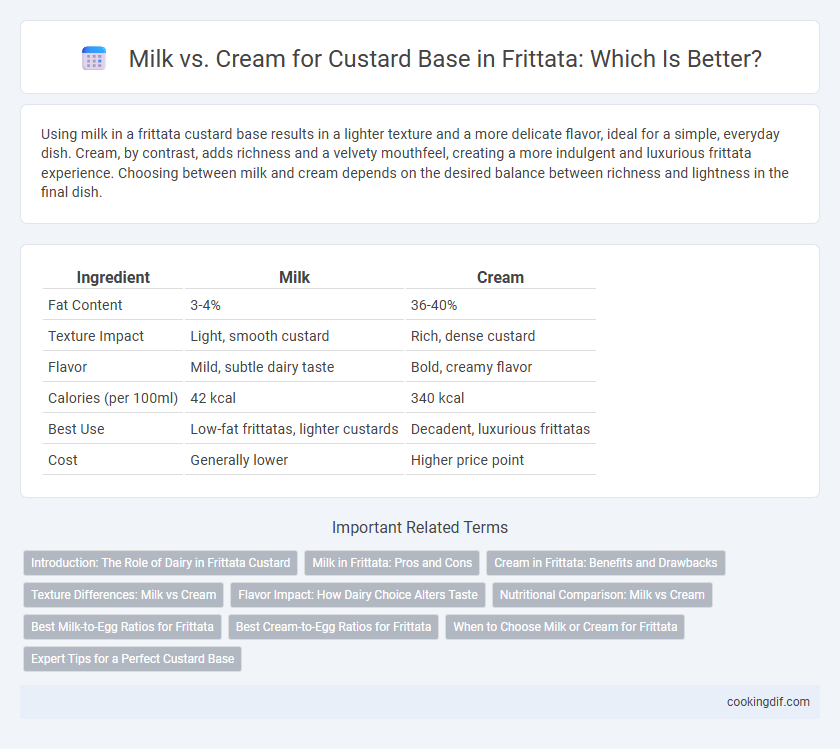Using milk in a frittata custard base results in a lighter texture and a more delicate flavor, ideal for a simple, everyday dish. Cream, by contrast, adds richness and a velvety mouthfeel, creating a more indulgent and luxurious frittata experience. Choosing between milk and cream depends on the desired balance between richness and lightness in the final dish.
Table of Comparison
| Ingredient | Milk | Cream |
|---|---|---|
| Fat Content | 3-4% | 36-40% |
| Texture Impact | Light, smooth custard | Rich, dense custard |
| Flavor | Mild, subtle dairy taste | Bold, creamy flavor |
| Calories (per 100ml) | 42 kcal | 340 kcal |
| Best Use | Low-fat frittatas, lighter custards | Decadent, luxurious frittatas |
| Cost | Generally lower | Higher price point |
Introduction: The Role of Dairy in Frittata Custard
Milk provides a lighter, more delicate texture in frittata custards, while cream contributes a richer, denser consistency due to its higher fat content. The choice between milk and cream directly influences the moisture level and mouthfeel of the final dish, affecting how the eggs set during cooking. Balancing dairy fat content is essential for achieving the desired custard stability and flavor depth in a frittata.
Milk in Frittata: Pros and Cons
Milk in frittata custard bases offers a lighter texture and lower fat content compared to cream, making it ideal for a healthier dish without compromising moisture. Its higher water content can result in a slightly less rich and less creamy frittata, which some may find less indulgent. Using milk also reduces calorie and cholesterol levels, appealing to those seeking balanced nutrition in breakfast or brunch recipes.
Cream in Frittata: Benefits and Drawbacks
Cream in a frittata custard base contributes to a richer texture and deeper flavor due to its higher fat content compared to milk. The fat in cream helps create a creamy, tender interior, enhancing mouthfeel while preventing the eggs from becoming rubbery. However, using cream can also increase calorie count and may result in a denser frittata, which some might find too heavy.
Texture Differences: Milk vs Cream
Milk in a frittata custard base creates a lighter, more tender texture with a subtle creaminess, allowing the eggs to shine through. Cream produces a richer, denser custard, resulting in a luxurious, velvety mouthfeel and a more decadent bite. The choice between milk and cream directly influences the frittata's moisture level and overall silkiness, with cream enhancing moisture retention and milk offering a delicate fluffiness.
Flavor Impact: How Dairy Choice Alters Taste
Using cream in a frittata custard base creates a richer, more indulgent flavor profile due to its higher fat content, which enhances mouthfeel and adds buttery notes. Milk results in a lighter, slightly less creamy texture, allowing other ingredients like herbs and cheese to stand out more prominently. The dairy choice significantly impacts the overall taste experience, with cream offering a decadent depth and milk providing a balanced, subtle backdrop.
Nutritional Comparison: Milk vs Cream
Milk provides a lower calorie and fat content compared to cream, making it a healthier choice for a frittata custard base. Cream contains higher saturated fat and calories, which increase richness but also cardiovascular risk if consumed excessively. For a balanced nutrition profile, using milk reduces total fat and cholesterol, supporting heart health while maintaining adequate protein and calcium levels.
Best Milk-to-Egg Ratios for Frittata
Using whole milk in a frittata custard base typically requires a 1:4 milk-to-egg ratio for a creamy texture without excessive richness. Heavy cream offers a richer custard but should be used sparingly at a 1:6 cream-to-egg ratio to prevent a dense consistency. Balancing these ratios ensures a perfectly set frittata with optimal moisture and flavor intensity.
Best Cream-to-Egg Ratios for Frittata
For a rich and creamy frittata custard base, the ideal cream-to-egg ratio ranges from 1/4 cup of cream per 4 large eggs to achieve optimal texture and flavor. Using whole milk instead results in a lighter custard but may lack the luscious mouthfeel cream provides, making it less suitable for achieving a dense custard consistency. Maintain the cream ratio within 15-25% of the total egg volume to ensure a balanced frittata that is neither too runny nor too firm.
When to Choose Milk or Cream for Frittata
Milk offers a lighter texture and fewer calories, making it ideal for a delicate frittata with a fluffier custard base, especially when aiming for a healthier option. Cream provides richer flavor and a denser, creamier custard, perfect for indulgent frittatas featuring bold ingredients like cheese or smoked meats. Selecting milk or cream depends on desired texture and richness, with milk for subtle dishes and cream for a luxurious, hearty bite.
Expert Tips for a Perfect Custard Base
Using cream instead of milk in a frittata custard base results in a richer, silkier texture, enhancing the custard's creaminess and overall flavor. Experts recommend a ratio of two parts eggs to one part dairy, with heavy cream preferred for its higher fat content that creates a luxurious mouthfeel, while whole milk offers a lighter custard with a more delicate taste. For optimal results, whisk the eggs vigorously with the chosen dairy and seasonings to achieve a smooth, homogenous mixture that ensures even cooking and a fluffy, tender frittata.
Milk vs Cream for custard base Infographic

 cookingdif.com
cookingdif.com